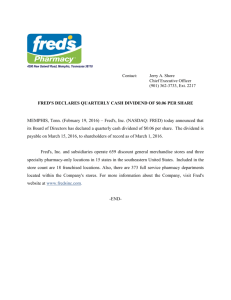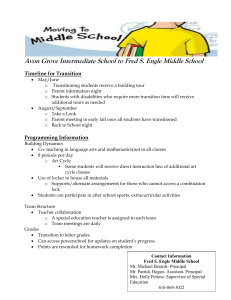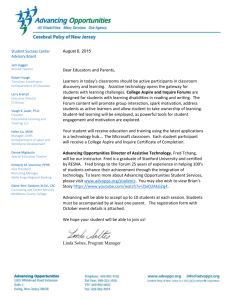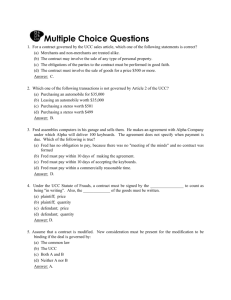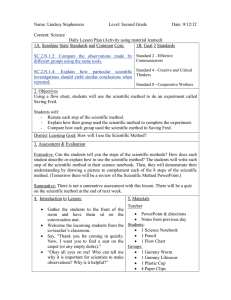Lesson 1 Save Fred - Catawba County Schools
advertisement
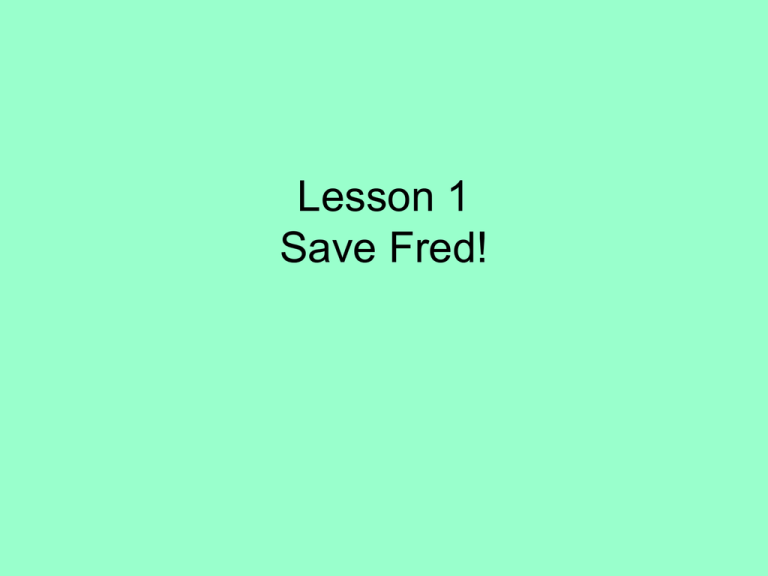
Lesson 1 Save Fred! Key Vocabulary Copy key vocabulary in Interactive Notebook • Hypothesis • Scientific Method 1 Solving Problems: Save Fred! We all solve problems every day—from little problems like what to wear to school, to bigger problems like whether to get a job or go to college. Different kinds of problems require different problemsolving approaches. One problem can often be solved in more than one way. What do you do when you are faced with a problem? What approaches do you use to solve problems? What approaches do scientists use to solve various kinds of problems? Materials For each pair of students • 1 gummy candy life preserver • 1 gummy candy worm • 1 plastic cup • 4 paper clips For each student • 1 Student Sheet 1.1 “Anticipation Guide: Ideas about Experimental Design Procedure • 1. Complete Student Sheet 1.1 “Anticipation Guide: Ideas about Experimental Design.” Complete the “Before” column only. • 2. Work with your partner to solve the problem below. A picture of the set-up is on the next page. Save Fred! Poor Fred! He was sailing along on a boat (your plastic cup) when a strong wind blew it upside-down. Fred (your candy worm) ended up on top of the upside-down boat. Unfortunately for Fred, his life preserver (your candy life preserver) is still trapped under the boat. Your job is to place the life preserver firmly around Fred’s body, but you must obey three rules: • 1. Fred may not fall into the “sea” (onto the table) more than one time; if he does, Fred “drowns.” • 2. You may not injure him in any way. • 3. You may use only the four paper clips to move Fred, the boat, and the life preserver. You may not touch anything except the paper clips. Save Fred! • 3. Work with your partner to record in your science notebook exactly what you did to save Fred. Be as specific as possible. - For example, did you modify one of the paperclips? -How did you avoid hurting Fred? -You may wish to draw a picture or a diagram to explain your procedure. • 4. Exchange your procedure with your table partners’ procedure. Do you think you could follow their procedure? If not, ask them to clarify their descriptions. Begin Analysis 1. You can solve problems in many different ways. In fact, you may use more than one way to solve a single problem. You can: develop a plan act out the problem work backward simplify the problem find a pattern draw a picture or a diagram. make a list guess and test. write an equation construct a table or graph. use objects to model the problem a. Which of these ways did you and your partner use to save Fred? b. Choose three of these ways and record a problem that could be solved using each method. 2. As a class, discuss the ways in which various groups of partners saved Fred. How were your problem-solving methods similar? How were they different? Analysis 3. Do you think scientists follow only one method to solve problems? Explain. Solving Problems: Save Fred! • Activity 1 A 4. The traditional scientific method includes the following steps for solving problems. Step 1. State the problem or question. Step 2. Propose an explanation, also known as the hypothesis. Step 3. Collect evidence. (Conduct an experiment.) Step 4. Analyze data. Step 5. Draw conclusions, and, if necessary, revise and repeat the experiment. When you saved Fred did you follow all of these steps in this order? Explain. Analysis 5. Do you think scientists always follow all of these steps in this order? Explain. 6. Fill in the “After” column for statements 1 and 2 only on Sheet 1.1, “Anticipation Guide: Ideas about Experimental Design.” Did your thinking change? 7. Reflection: People face problems in their lives every day. What did you learn from this activity that you can use to solve other problems? How do you think this compares with how scientists solve problems? End of Lesson


